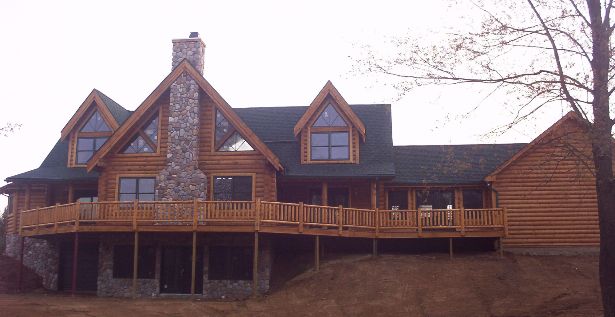Log Homes

Log homes come with a number of advantages, including:
Trees are Renewable Resource
Since trees are a renewable resource, log and timber homes come with a solid green pedigree. When a home is made from solid logs, you are effectively taking the carbon contained in those logs out of environmental circulation over the entire life of the home. Moreover, some log and timber home producers harvest standing dead timber (done in by pesky insects) or purchase logs from forests certified as sustainable. Some builders are constructing log and timber homes to green building standards as well.
Long Lasting
Got a know-it-all in the neighborhood who thinks his brick home is durable? Inform him that log and timber homes still in use in Europe routinely date back more than 800 years. And one log-constructed church in Russia is reportedly more than 1,700 years young.
Withstand Mother Nature’s Wrath
The log and timber home industry has countless stories of these homes successfully weathering the worst weather Mother Nature can dish out, including the 2005 Hurricane Katrina
Fit the Land
Since this organic building material comes from nature, the resulting structures blend into the topography like a 10-point buck on opening day. Log homes naturally integrate right into the landscape, rather than being awkwardly imposed on it.
Fast Framing
If you choose to use a precut and pre-drilled log system or a handcrafted home, the shell of your home can be framed on site faster than conventional stick framing, which will reduce the likelihood of weather-related damages or mold and mildew issues. With the right crew and building system, it can be weather tight quickly.
Warmth of Wood
Warm to the touch (as opposed to the always chilly sheetrock), wood has something called “thermal mass,” a natural property in the logs that helps keep inside temperatures of homes comfortable in all seasons. This allows log walls to collect and store energy, then radiate it back into the home.
Super Energy Efficient
Provided the home is sealed properly (between the foundation and the first course of logs, between log-to-log connections, and where the roof system meets the log wall), you can have a super energy efficient home. Indeed, some builders routinely build log and timber homes to meet the DOE’s “Energy Star” standards. This means it will be 30% more efficient than what building codes call for, saving you serious energy costs over the life of the home. Today we can build a log and timber home to be 15 to 20 percent more energy efficient than a conventional home.
A Picture is Worth a Thousand Words
Hanging a picture in a home with drywall is a big ordeal, involving a stud finder, a hammer or drill and bruised fingers—maybe even a bruised ego, since your spouse may tell you to move the picture, requiring patch work. Homeowners report the simplicity of hanging a picture is one the simple joys of living in a log and timber home.
Rustic Doesn’t Mean It Isn’t High Tech
While rugged is appealing, roughing it is definitely out. That’s why today’s log and timber homeowners increasingly want a hideaway that’s connected, automated, and secure. Many log and timber homeowners are adding backup generators (in case of power outages), security systems, and CAT 5 wiring systems that can accommodate high speed video, voice and data, as well as a host of new communication technologies on the horizon.
The Eyes Have It
If you’re worried about mold, mildew or insect infestation, then a log and timber home offers clear advantages since you’ll be able to see anything untoward, just by taking a stroll around your home and visually inspecting the logs. This quick detection leads to a less costly remedy in contrast to conventional homes with sealed wall cavities that can be a hidden refuge for mold, mildew, and insect infestation which can cause far more damage before being detected.
Superior Craftsmanship
Conventional custom homes can have their fare share of beautiful carpentry, but this is typically limited to trim and millwork. In log and timber homes, examples of fine craftsmanship are at every turn, in the handcrafted staircase with its branch-like spindles and balustrade, in the hand-scribed large timbers overhead in the cathedral ceiling, and in the one-of-a-kind light fixtures.
Peace & Quiet
Log homes are often quieter than stick built homes, thanks to the same thermal mass that provides energy efficiency and the sound deadening effects of wood walls. According to a white paper produced by the National Association of Home Builders Log and Timber Homes Council, “the acoustical benefits of a log wall, therefore, are the reduced transmission provided by its solid mass and the sound deflection provided by the profile of the log (the angle, shape, and texture of the log surface).”
